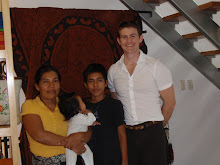


I met Lucas back in 1998 when I made my first "alpaca" trip to Bolivia. He was the head weaver for a small handloom outfit in El Alto. La Paz has a stunning setting in a steep canyon high up in the Altiplano south of Lake Titicaca. You can see the streets running up the sides of the canyon until it gets really steep, then they make switchbacks. There is only so much room, and then there is El Alto. Above the canyon, the Altiplano is relatively flat, but also very windy, bleak and cold. This is where El Alto was born and continues to sprawl in rampant, disorganized fashion. Land is cheaper here, and growth had nowhere else to go. This is where the weaving workshop was. Even though the weavers always had a few electric heaters going, it was hard to ever get warm. There's something about concrete block construction that just sucks the heat out of you. By the way, the workshop did eventually relocate to the balmy burg of Cochabamba, where they are still weaving, albeit in much greater comfort.
I worked with Lucas and the other weavers for about ten years. Last year, Lucas sent me an email out of the blue to tell me he had gone back to Peru (where he is from) and had begun his own weaving workshop. We arranged to meet during a trip down last April. He and Felipe, who also was a weaver at the same workshop in Bolivia, met me at the bus station the night I arrived in Juliaca. The air is thin and cold at 13,000ft so we went straight to the hotel and sat down for dinner in the lobby restaurant. After a round of pisco sours, I ordered the Titicaca lake trout, which is always delicious. The next day, we met in town and took a moto-taxi (like a motorized rickshaw) a short distance from town. It was a humble building with electricity but without plumbing (there is an outhouse behind). The view across the road is quite rural and beautiful- note the shepherds, flocks and adobe dwellings. It was great to greet the weavers' families (whom I hadn't seen in a few years) and give some chocolates to the kids. We all shared some Inca Kola and started discussing our weaving project.

















